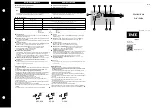
Instruction Leaflet
DT3000
Page 18
Effective: Date 07/02
I.B. 17555D
For more information visit:
www.cutler-hammer.eaton.com
Supersedes I.B. 17555C dated November 1999
Terminals 12 and 13 are a “NO” configurable contact. DIP
Switch S3 is used to configure the trip contacts. With DIP
Switch S3 in the “
OFF
” position, this contact closes when
the relay detects a need for the circuit breaker to trip due
to either a phase or ground instantaneous fault or the
discriminator function. With DIP Switch S3 in the “
ON
”
position, this contact closes when the relay detects a need
for the circuit breaker to trip due to any type of ground
fault.
Terminals 14 and 15 are also a “NO” configurable contact.
With DIP Switch S3 in the “
OFF
” position, this contact
closes when the relay detects a need for the circuit breaker
to trip due to an inverse time overcurrent or short time
function. The contact also operates when the
communication interface initiates an action to open the
circuit breaker. With DIP Switch S3 in the “
ON
” position,
this contact closes when the relay detects a need for the
circuit breaker to trip due to any type of phase fault or
communications.
Rear Surface Terminals:
The rear surface terminals,
identified as (A1, A2), (B1, B2), (C1, C2) and (G1, G2)
provide the current transformer input connection points
and are rated for 5 ampere inputs. (A1, A2), (B1, B2) and
(C1, C2) are phase A, B, C current inputs respectively,
while (G1, G2) is the ground current input.
2-2.3 EXTERNAL HARDWARE
The Digitrip 3000 Protective Relay requires that a
customer supplied source of input control power be wired
into the TB1 terminal block located on the rear panel.
Refer to the typical wiring diagram in Figure 3-1. A power
supply can be either ac or dc voltage within the acceptable
voltage ranges outlined in “UL Testing and Specification
Summary.”
















































